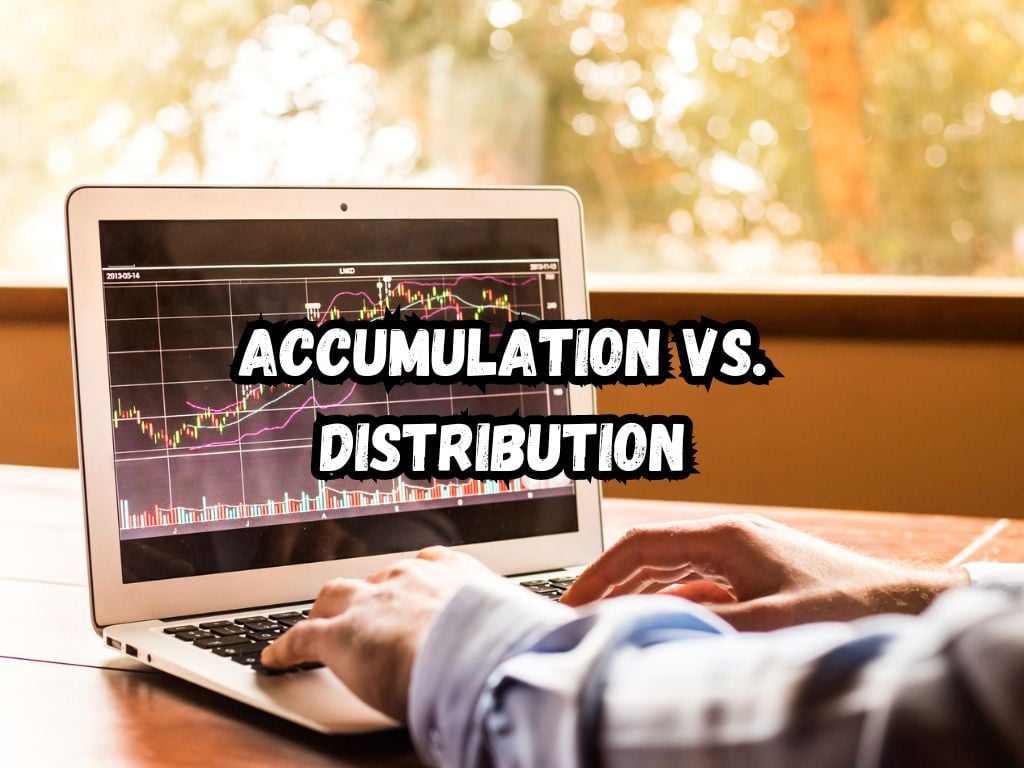In the landscape of trading, two concepts that emerge as crucial for understanding market dynamics are accumulation and distribution.
These terms paint a picture of the underlying forces that drive market prices. Grasping these concepts equips traders with the insight needed to predict future movements effectively. Let’s compare accumulation vs distribution.
Understanding Accumulation
Accumulation typically occurs when investors buy stocks over a period, anticipating future price increases. This buying is often the result of positive news or strong financials of the company.
During accumulation, the stock’s price may not reflect significant upward movements as these large purchases are offset by regular or negative market sentiment. However, this phase sets the groundwork for future bullish trends.
Signs of accumulation include an increase in volume without a significant change in price. Often, this scenario suggests that smart investors are gathering stocks discreetly.
The impact on long-term price trends can be profound. After a period of accumulation, stocks often enter a phase of price increase as the market begins to recognize their value.

Understanding Distribution
Conversely, distribution represents a phase where investors begin selling their holdings, typically after a significant run-up in prices.
This phase can occur when investors perceive that there will be no further gains or that future prospects look bleak. Distribution results in a greater supply of stock than demand, leading to a fall in prices.
Signs of distribution include increased volume accompanied by a decreasing price trend. This indicates that sellers are eager to unload their shares, often leading to a bearish market outlook. The effects are usually a gradual decline in prices as these stocks move from stronger to weaker hands.
Accumulation vs Distribution: Comparative Analysis
The key difference between accumulation and distribution lies in their impact on market sentiment and price movements.
Accumulation can be seen as a gathering of power, a bullish signal that suggests prices might increase. Distribution, however, hints at a decline, with prices expected to fall as stocks are offloaded.
By analyzing charts, traders can spot these phases. Charts that show long periods of stable prices followed by a sudden upward movement may indicate accumulation.
In contrast, charts that display a steady price followed by a decline could signify distribution. Understanding these patterns helps traders make informed decisions.
Identifying Accumulation and Distribution
Identifying these phases involves a keen eye on volume changes relative to price. During accumulation, despite high buying volume, prices may not increase significantly due to the balance of selling pressure.
Conversely, in distribution, even though selling volume is high, prices might decrease significantly due to the overpowering selling pressure.
Traders can use various technical indicators to identify these phases. Tools like On-Balance Volume (OBV) and Accumulation/Distribution Line help in assessing the flow of volume. When these indicators rise, it might suggest accumulation, while a decline could suggest distribution.
Strategy Development
Incorporating knowledge of accumulation and distribution into trading strategies is vital. During accumulation, taking a buy position might be beneficial as an uptrend could follow. During distribution, traders might consider selling or shorting as a downtrend could ensue.
Risk management is crucial in both phases. Setting stop-loss orders and taking profits at predetermined levels can help safeguard investments.
Traders should consider whether they are outfitted for short-term skirmishes or long-term campaigns, as this will dictate their approach during these phases.

Advanced Tips and Common Pitfalls
Experts advise keeping a disciplined approach to trading these phases. One common mistake is acting on assumptions without confirmation from additional indicators.
This premature action can lead to misjudging the market phase, which might result in significant losses.
Frequently Asked Questions
What are accumulation and distribution in the context of trading?
Accumulation involves buying sizable amounts of stock without causing price to rise significantly, typically in anticipation of future gains. Distribution involves selling stock after price increases, often resulting in a price decline.
How can traders identify the shift from accumulation to distribution?
Traders can watch for changes in volume and price. A rise in volume without a corresponding increase in price might signal accumulation. A high volume sell-off, with price decline, often indicates distribution.
Which technical analysis tools are best for detecting accumulation/distribution?
Tools such as On-Balance Volume (OBV) and the Accumulation/Distribution Line are effective. These tools measure volume flow and can indicate whether a stock is being accumulated or distributed.
Can accumulation and distribution be used in all markets?
Yes, though these concepts are most commonly used in stock trading, they are applicable in other markets such as forex and commodities, portraying universal market behaviors.
Conclusion
Understanding accumulation and distribution provides a lens through which to view market momentum, guiding traders in their decision-making process.
Mastery of these concepts—coupled with practical application—can improve one’s trading performance significantly. As with any strategy, continuous learning and adaptation are key to navigating these market phases effectively.


 Tags:
Tags:










